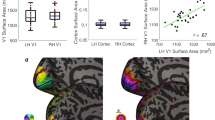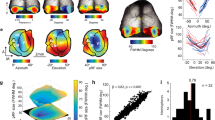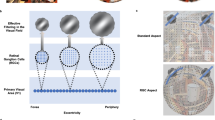Abstract
IT has long been contentious whether the large representation of the fovea in the primate visual cortex (VI)1–8 indicates a selective magnification of this part of the retina7, 9–11, or whether it merely reflects the density of retinal ganglion cells12–14. The measurement of the retinal ganglion-cell density is complicated by lateral displacements of cells around the fovea and the presence of displaced amacrine cells in the ganglion cell layer. We have now identified displaced amacrine cells by GABA immunohistochemistry and by retrograde degeneration of ganglion cells. By reconstructing the fovea from serial sections, we were able to compare the densities of cones, cone pedicles and ganglion cells; in this way we found that there are more than three ganglion cells per foveal cone. Between the central and the peripheral retina, the ganglion cell density changes by a factor of 1,000–2,000, which is within the range of estimates of the cortical magnification factor1–8. There is therefore no need to postulate a selective magnification of the fovea in the geniculate and/or the visual cortex.
This is a preview of subscription content, access via your institution
Access options
Subscribe to this journal
Receive 51 print issues and online access
$199.00 per year
only $3.90 per issue
Buy this article
- Purchase on Springer Link
- Instant access to full article PDF
Prices may be subject to local taxes which are calculated during checkout
Similar content being viewed by others
References
Talbot, S. A. & Marshall, W. H. Am. J. Ophthalmol. 24, 1255–1264 (1941).
Daniel, P. M. & Whitteridge, D. J. Physiol., Lond. 159, 203–211 (1961).
Cowey, A. J. Neurophysiol. 27, 366–393 (1964).
Rolls, E. T. & Cowey, A. Expl Brain Res. 10, 298–310 (1970).
Hubel, D. H. & Wiesel, T. N. J. comp. Neurol. 158, 295–305 (1974).
Dow, B. M., Snyder, A. Z., Vautin, R. G. & Bauer, R. Expl Brain Res. 44, 213–228 (1981).
Van Essen, D. C., Newsome, W. T. & Maunsell, J. H. R. Vision Res. 24, 429–448 (1984).
Tootell, R. B. H., Switkes, E., Silverman, M. S. & Hamilton, S. L. J. Neurosci. 8, 1531–1568 (1988).
Malpeli, J. G. & Baker, F. H. J. comp. Neurol. 161, 569–594 (1975).
Myerson, J., Marris, P. B., Miezin, F. M. & Allman, J. M. Science 198, 855–857 (1977).
Perry, V. H. & Cowey, A. Vision Res. 25, 1795–1810 (1985).
Drasdo, N. Nature 266, 554–556 (1977).
Rovamo, J. & Virsu, V. Expl Brain Res. 37, 495–510 (1979).
Schein, S. J. & de Monasterio, F. M. J. Neurosci. 7, 996–1009 (1987).
Wong, R. O. L. & Hughes, A. J. comp. Neurol. 255, 159–177 (1987).
Wässle, H., Chun, M. H., & Müller, F. J. comp. Neurol. 265, 391–408 (1987).
Missotten, L. Invest. Opthalmol. Vis. Sci. 13, 1045–1049 (1974).
Perry, V. H. & Cowey, A. Neuroscience 25, 225–236 (1988).
Schein, S. J. J. comp. Neurol. 269, 479–505 (1988).
Boycott, B. B., Hopkins, J. M. & Sperling, H. G. Proc. R. Soc. B 229, 345–379 (1987).
Röhrenbeck, J., Wässle, H. & Boycott, B. B. Eur. J. Neurosci. 1, 407–420 (1989).
Sakitt, B. Vision Res. 22, 417–421 (1982).
Mallot, H. A. Biol. Cybern. 52, 45–51 (1985).
Tusa, R. J., Palmer, L. A. & Rosenquist, A. C. J. comp. Neurol. 177, 213–235 (1978).
Sanderson, K. J. Expl Brain Res. 13, 159–177 (1971).
Wässle, H. & Chun, M. H. J. comp. Neurol. 297, 43–54 (1989).
Abercrombie, M. Anat. Rec. 94, 239–247 (1946).
Sterio, D. C. J. Microsc. 134, 127–136 (1984).
Gundersen, H. J. G. J. Microsc. 143, 3–45 (1986).
Allen, K. A., Curcio, C. A. & Kalina, R. E. Invest. Ophthalmol. Vis. Sci. 30, 347 (1989).
Penfield, W. & Rasmussen, T. The Cerebral Cortex of Man: A Clinical Study of Localization of Function (Macmillan, New York, 1950).
Koontz, M. A., Hendrickson, A. E. & Ryan, M. K. Vis. Neurosci. 2, 19–25 (1989).
Author information
Authors and Affiliations
Rights and permissions
About this article
Cite this article
Wässle, H., Grünert, U., Röhrenbeck, J. et al. Cortical magnification factor and the ganglion cell density of the primate retina. Nature 341, 643–646 (1989). https://doi.org/10.1038/341643a0
Received:
Accepted:
Issue Date:
DOI: https://doi.org/10.1038/341643a0
This article is cited by
-
Evaluation of the Glaucomatous Macular Damage by Chromatic Pupillometry
Ophthalmology and Therapy (2023)
-
Establishing the ground squirrel as a superb model for retinal ganglion cell disorders and optic neuropathies
Laboratory Investigation (2021)
-
Uniform spatial pooling explains topographic organization and deviation from receptive-field scale invariance in primate V1
Nature Communications (2020)
-
Ring analysis of multifocal oscillatory potentials (mfOPs) in cCSNB suggests near-normal ON–OFF pathways at the fovea only
Documenta Ophthalmologica (2020)
-
An S-cone circuit for edge detection in the primate retina
Scientific Reports (2019)
Comments
By submitting a comment you agree to abide by our Terms and Community Guidelines. If you find something abusive or that does not comply with our terms or guidelines please flag it as inappropriate.



